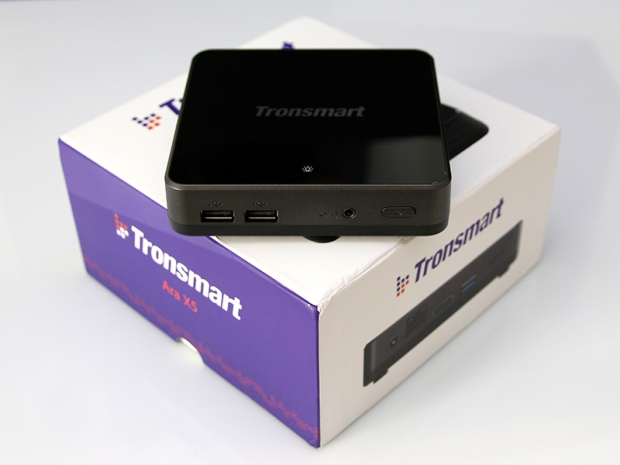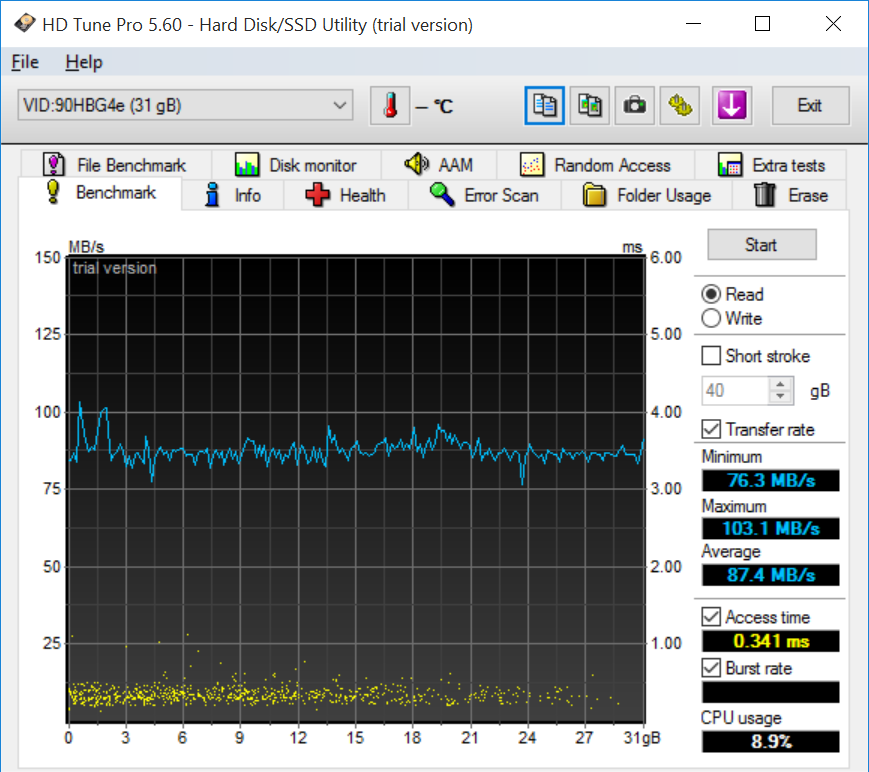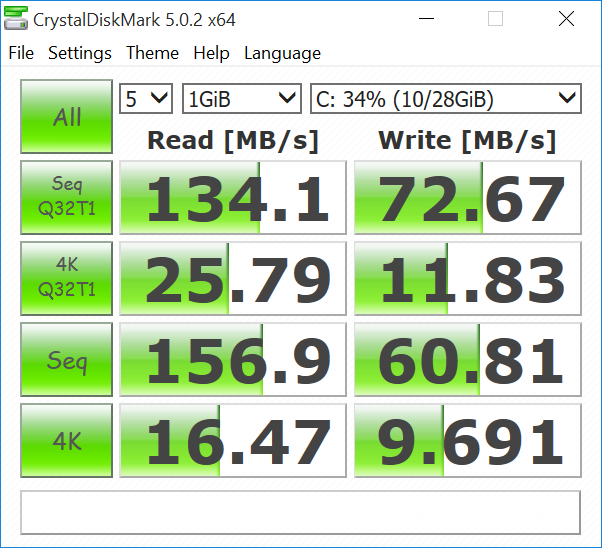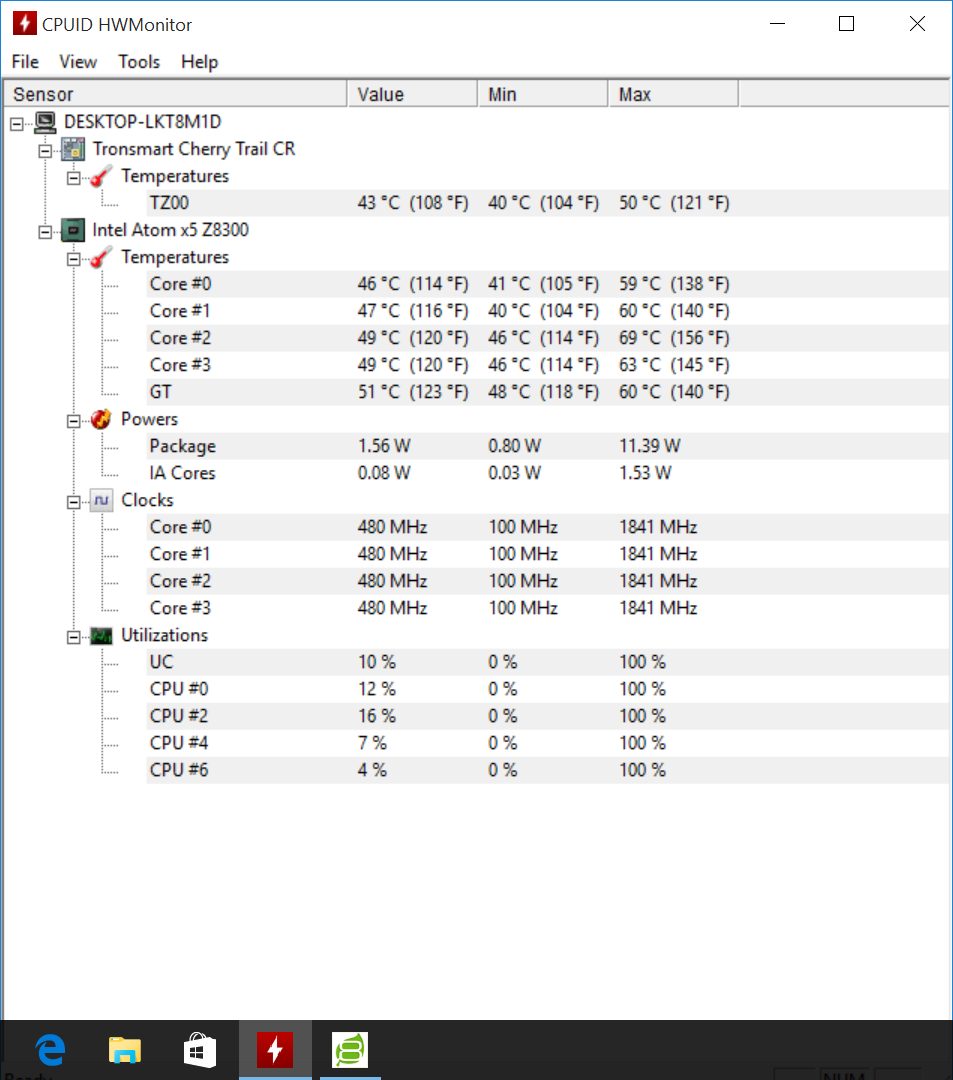Intel’s Bay Trail Atom processors have been around for almost two years, and during that time we’ve tested a range of different devices based on these 22nm parts. Our first encounter with a Bay Trail SoC was the Asus T100TA Transformer tablet in late 2013, and since then, we’ve reviewed loads of Bay Trail devices, with prices ranging from $99 to $499. Now it’s time for Bay Trail to fade away, but don’t worry; the replacement is very good indeed.
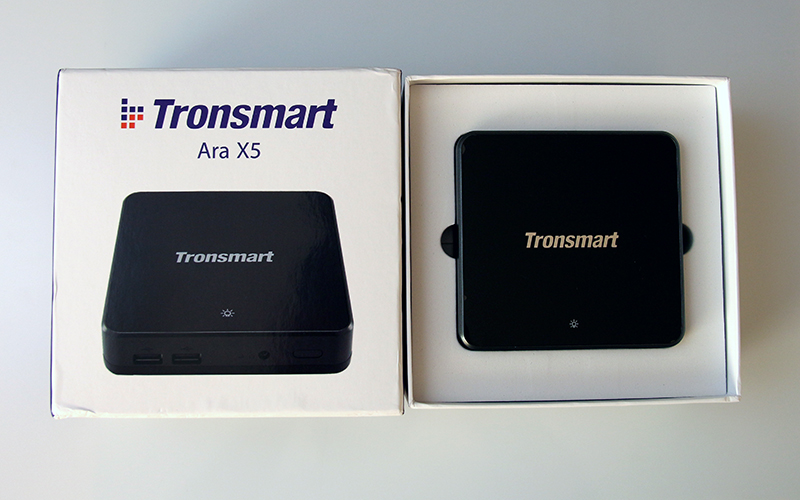
Intel Cherry Trail Atoms are taking over, and now that the new 14nm parts are showing up in a wide range devices, we went about looking for some samples. This is easier said than done because a lot of Cherry Trail products have been announced, but not that many are widely available in Europe. In addition to cheap 2-in-1s and tablets, Cherry Trail processors are also coming to small form factor machines, and we managed to get one of the first micro PC’s based on the new chip. It’s called the Tronsmart Ara X5 and it’s priced at $149 w/ free shipping via Chinese reseller Geekbuying.
The box is based on an Atom x5-Z8300 with 2GB of RAM and 32GB of storage. This is more or less standard for this product category, although we’ve seen micro PCs with 4GB of RAM and more storage. It all depends on the SKU you are going after (and your budget). We don’t mind seeing 2GB of RAM and cramped storage on these systems due to their low price: At $100-150, the whole point of such PCs is to keep them as affordable as possible, making them an attractive choice for secondary or even tertiary devices.
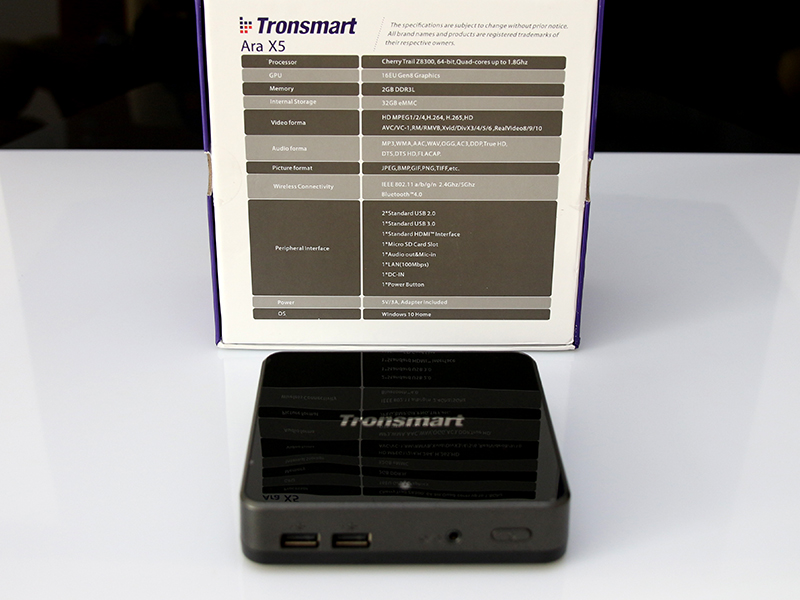
Apart from the new 14nm processor, the Tronsmart Ara X5 is more or less a standard micro PC. You get two USB 2.0 ports, a USB 3.0 port, HDMI, and Micro SD slot. Broadcom’s AP6330 WiFi module takes care of 802.11a/b/g/n in 2.4GHz and 5GHz, and it also delivers Bluetooth 4.0 support. A standard LAN port is on board as well.
That’s more or less it, but before we take a closer looks at the chip and performance, let’s cover the basics and check out the device itself.
Design and Build Quality
The Tronsmart Ara X5 is a micro PC, measuring 115 x 120 x 27mm (4.65 x 4.47 x 1.06in). It’s roughly the size of three CD jewel cases stacked on top of each other. The design is simple and utilitarian. There’s no faux metal, no pastel colours or any other design features that would make it stand out.

The front of the device features two USB ports, an audio jack, activity LED and power button.

At the rear you’ll find the rest of the connectors: HDMI, LAN, USB 3.0, DC in, micro SD slot.

From an ergonomic point of view, everything makes sense.
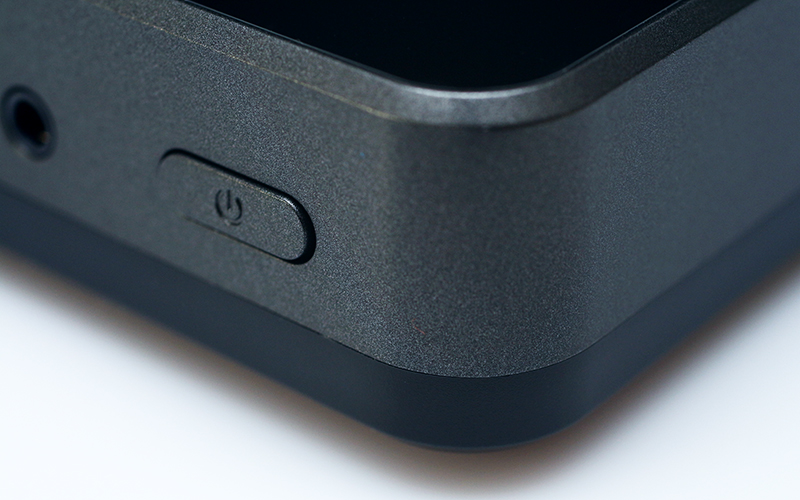
While the design isn’t too exciting, build quality is good and we have no complaints in this respect. The Tronsmart weighs 211g.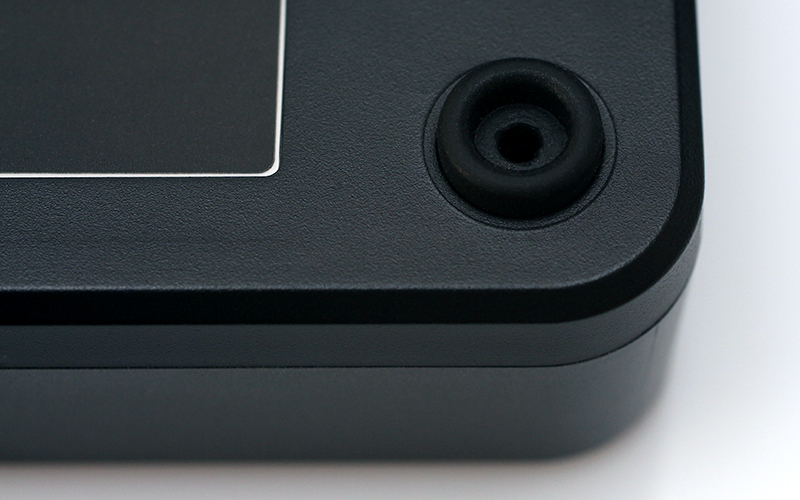
The chassis is fashioned out of an acrylic panel, and the bottom is quite thick and sturdy. The device rests on four rubber feet, which allow for some airflow through the vents at the bottom.
The real fun starts under the bonnet.
Tronsmart Ara X5 Specs and Performance
Cherry Trail is not exactly a revolutionary processor design. It’s a “tock” in Intel’s “tick-tock” model. The CPU portion of the SoC is basically a die shrink of Bay Trail, manufactured using the latest 14nm node. The Airmont architecture is just a slightly modified Silvermont architecture, but since it’s manufactured in a superior node, it should deliver better sustained performance and higher CPU utilisation.
However, the transition to 14nm also left Intel with a lot of die space to play around with, and the chipmaker put it to good use by sticking a more powerful GPU in the package. Whereas Bay Trail relied on Ivy Bridge (Gen7) graphics, Cherry Trail features a new Gen 8 GPU, based on the same architecture you would find in its Broadwell big-cores. This means you get 4K/h.265 video acceleration, along with DirectX 11.2 support. The GPU supports up to two displays.
Since the new process allowed Intel to cram more transistors on the same die area, the GPU was bumped up from 4 execution units (EUs) to 12 or 16 EUs, depending on the SKU. Atom x5 parts sport 12 EUs, while x7 processors have 16 EUs.
This particular SKU, the Atom x5-Z8300, features four CPU cores and 12 EUs. The CPU is clocked at 1.44GHz to 1.84GHz, while the GPU runs at 200MHz to 500MHz. Despite the spec bump, the 14nm node allowed Intel to keep thermals in check, and the official SDP is just 2W.
The chip has 2MB of cache and it’s capable of addressing 2GB of DDR3L-RS 1600 memory (single channel). This is perhaps the chip’s biggest limitation. While 2GB wasn’t a big deal on Bay Trail over the past two years, we would have liked to see a bit more from Intel’s new entry-level SoC. Luckily, the rest of the Cherry Trail line-up supports up to 8GB of dual-channel memory, so this is only an issue for the x5-Z8300.
Speaking of which, Intel’s recommended customer price for this particular SoC is just $20. While this may sound like a bargain for an x86 chip, bear in mind that Cherry Trail isn’t exactly competing against AMD. It has to take on ARM-based SoCs from Qualcomm, MediaTek and other chipmakers.
Before we move on to the performance, let’s list the specs.
Tronsmart Ara X5 Specifications:
- Processor: Intel Atom x5-Z8300 quad-core, 1.44GHz base, 1.84GHz Turbo, 14nm
- Graphics: Intel HD Graphics Gen8, 200MHz base, 500MHz burst
- RAM: 2GB DDR3L
- Storage: 32GB eMMC, expandable via microSD card up to 32GB
- Wireless: dual-band 802.11b/g/n, Bluetooth 4.0 (Broadcom AP6330)
- Dimensions: 115 x 120 x 27mm (4.65 x 4.47 x 1.06in)
- Weight: 211g
- Ports: 2 x USB 2.0, 1x USB 3.0, HDMI, 3.5mm audio, 100Mbps RJ45, DC in (5V 3A)
- OS: Windows 10
Now, if all the talk of more EUs and Intel’s bleeding-edge 14nm silicon has you all worked up, get ready to curb your expectations. Like we said, Airmont is just a Silvermont die-shrink with beefed up graphics. Furthermore, the 8300 is the entry-level Cherry Trail part, with relatively low clocks and single-channel memory support.
In spite of this, we pitted it against the Atom Z3736F, which is basically the fastest widely available Bay Trail chip. In other words, we are comparing the fastest Bay Trail to the slowest Cherry Trail part due to the fact that the first batch of Bay Trail parts was discontinued a while ago, but you can still pick up loads of products based on Z3736F and Z3735 silicon (and they tend to be very cheap).
While it’s a 22nm part, the Z3736F maxes out at 2.16GHz, almost 300MHz more than the new x5-Z8300. Its GPU also runs at somewhat higher clocks, but it’s based on an ancient architecture and has just 4 EUs.
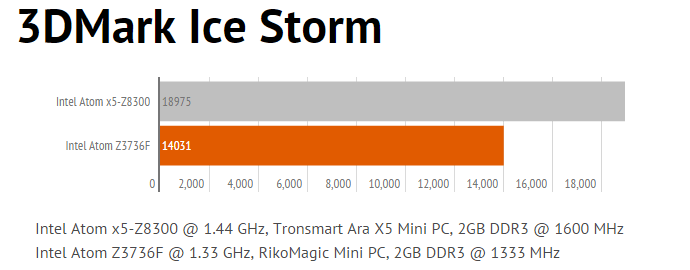
Long story short, even the entry-level Cherry Trail easily outpaces the Z3736F. In GPU tests, it ends up noticeably faster, plus it experiences less throttling. In 3DMark Ice Storm, it scores almost 19,000, ending up about 35% faster than the Z3736F.
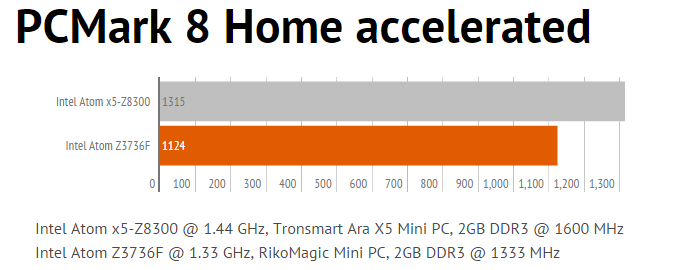
Despite the lower clock, the PCMark score is about 20% higher than on the Z3736F. The GPU also helps in video encoding and casual gaming tests. The biggest difference is evident in the Photo Editing v2 test, which the Cherry Trail system completes in just over a second, while the Bay Trail takes 2.65s.
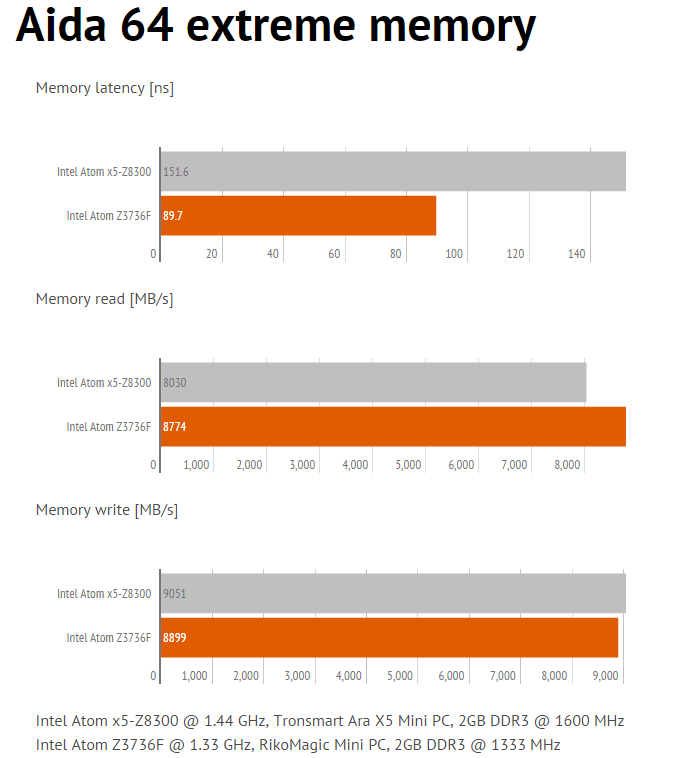
There is virtually no improvement on the memory front. In fact, in some cases, our Cherry Trail sample ended up slower than Z3736F systems we had a chance to test. However, it should be noted that this may be a vendor-specific score.
Speaking of which, we also tested the Ara X5’s storage and got average results. We’ve seen faster eMMC drives in some systems. On the other hand, we also encountered much slower storage on some units, so the Tronsmart gets a pass.
Sandra and Aida CPU tests favour Cherry Trail over Bay Trail, although the difference is not that big in some cases.
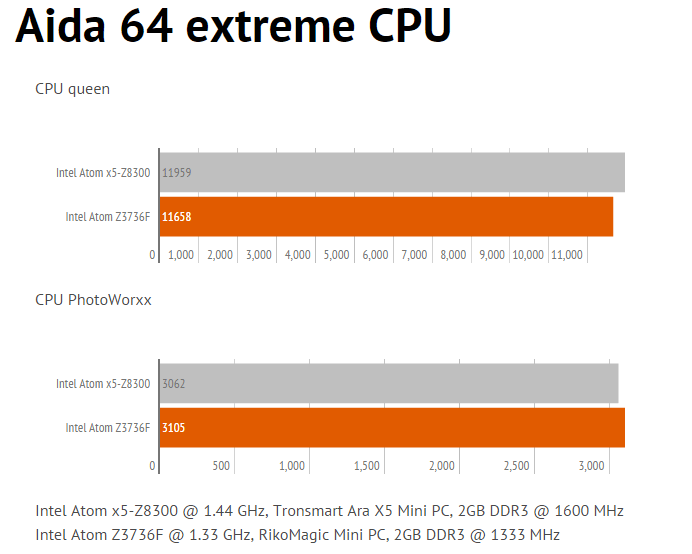
In fact, in the Aida PhotoWorxx test, the new SoC lags behind the Z3736F.
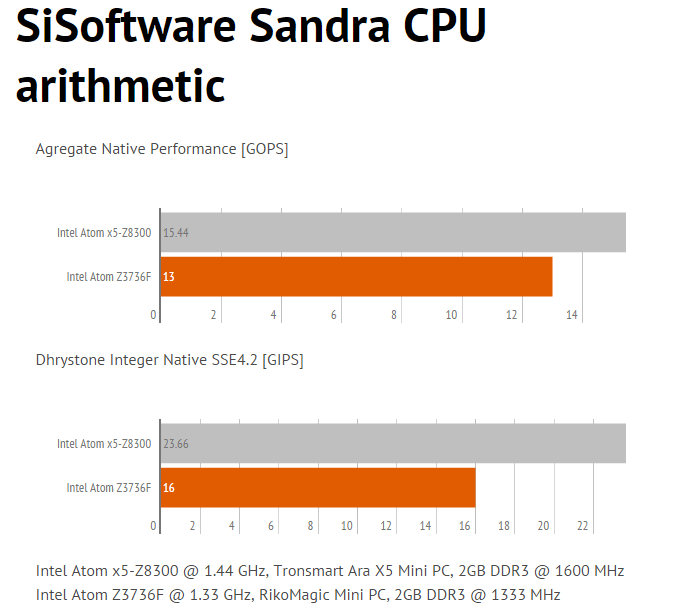
Sandra Arithmetic loves Intel's new silicon and the margin is pretty wide.
As far as thermals go, we were very pleased with the results. Cherry Trail is somewhat cooler than Bay Trail, especially if you’re not running GPU-bound applications (realistically, few people will push the GPU to the limits). The SDP stands at 2W, or 10% less than the Z3736F, but the biggest difference is in sustained performance. Cherry Trail can keep running at higher clocks for a bit longer, that’s the whole point.
Our unit reported a CPU temperature of 67 degrees Celsius after running a few benchmarks. There’s practically no throttling. This is obviously good news for anyone considering a Cherry Trail tablet or micro PC.

While Bay Trail still manages to keep up in terms of overall performance, it also runs out of steam much faster. That’s why many Bay Trail micro PCs, and even stick PCs, feature active cooling. It’s a lot easier to get away with passive cooling with Cherry Trail.

Although Tronsmart opted for a plastic-acrylic chassis, the acrylic plate at the bottom is relatively thick and appears to help spread the heat evenly.
Setup and Everyday Use
Like all micro-PCs, the Tronsmart is extremely easy to set up and use. You can boot it up in minutes from unboxing.
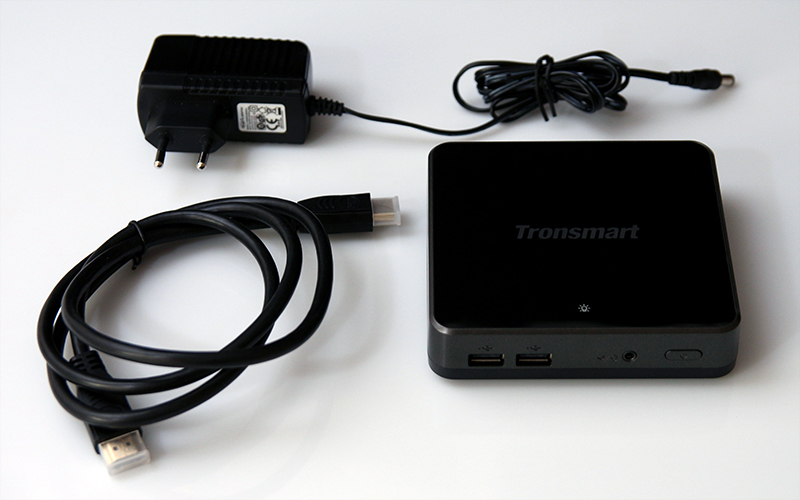
It does not rely on a standard micro USB charter for power, and it ships with a 5V 3A power brick. It has a full-size HDMI port at the back, along with RJ45 LAN. However, it’s not all good news.
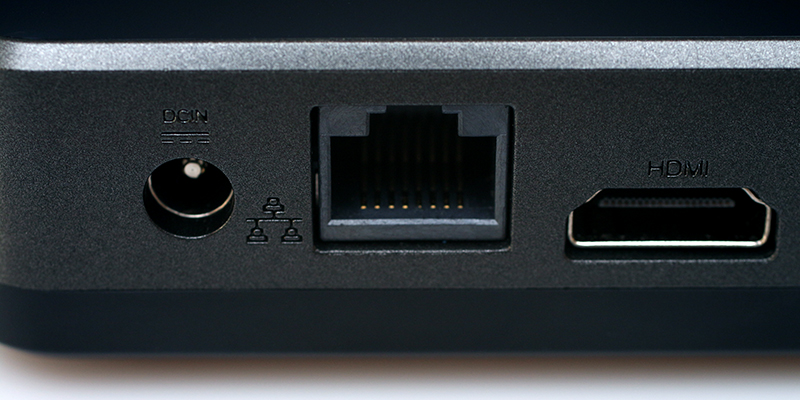
For starters, we experienced a few WiFi and Bluetooth issues. We are not sure whether this was a hardware problem with our particular unit, or possibly a Broadcom driver issue. Since the unit started shipping with Windows 10 and a new Intel platform just a couple of weeks after launch, we can’t discount the software side of things. Be as it may, the Tronsmart’s antennas struggled with WiFi next to a few Bay Trail tablets and PCs that worked like a charm. The signal was way too low and we were unable to sort it out. Bluetooth was another problem and we had trouble connecting our Bluetooth keyboard to the sample.
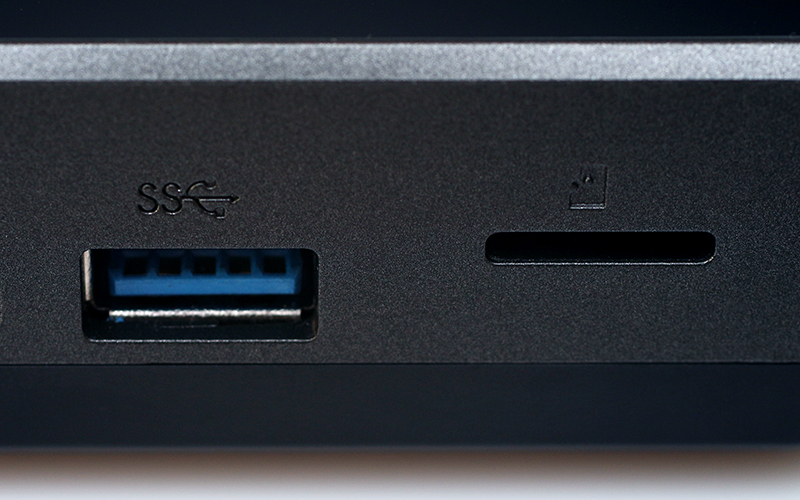
Another concern is the “USB 3.0” port at the back, because we didn’t exactly get USB 3.0 speeds on it. It doesn’t provide enough DC power to run an external hard drive, either.
Teething problems are quite common in pre-production samples, and when we factor in Windows 10 and Cherry Trail, it’s obvious that the manufacturer had a lot of unknowns to deal with. Still, we weren’t expecting such issues: WiFi, Bluetooth and USB 3.0 sound like pretty basic stuff, even for a pre-production sample.
Aside from these glaring issues, which can probably be attributed to the fact that this is an early sample, there’s not much to complain about. The connector layout is good, there’s an activity LED on board, the chassis doesn’t heat up too much, yet it’s relatively compact.
Conclusion
Intel’s new Atom looks like a promising piece of silicon. Built to a budget, the chip still manages to deliver a significant improvement on Bay Trail, especially in the GPU department. While GPU performance is not a huge deal on most cheap PCs, bear in mind that Cherry Trail will end up in millions of tablets running Android and Windows.
GPU performance was (and still is) the Achilles heel of Bay Tral SoCs, and Cherry Trail promises to change all that. However, it’s still not enough. High-end ARM processors, with the latest and fastest GPUs Qualcomm, ARM and Imagination Technologies GPUs, will still beat Cherry Trail in gaming, making them more suitable for premium tablets. However, Cherry Trail is an x86 chip and can also be used in tens of millions of Windows tablets and mini PCs.
Although it’s a “tock,” Cherry Trail is a good update and the chip looks like a winner. It’s a better all-round performer thanks to the new GPU, yet it’s more efficient and delivers more performance in the same thermal envelope. Also, bear in mind that this is an x5-Z8300 review – we haven’t had a chance to review the x5-Z8500, which can hit 2.24GHz on Turbo and address up to 8GB of memory (dual channel, naturally). Lastly, the x7-Z8700 is clocked at 1.6/2.4GHz and sports an even more powerful GPU, with 16 EUs.
Even the humble x5-Z8500 manages to beat the previous-gen Atom with a substantially higher clock, yet faster and more capable iterations of Cherry Trail SoCs should be much, much better.
As for the Tronsmart Ara X5, we liked the user-friendly design, the sturdy acrylic chassis, good thermals and relatively low price. However, we also encountered a few problems that may or may not be attributed to the fact that this is a pre-production unit. Hopefully, it’s just a matter of time before the WiFi/BT module gets a new driver that sorts these problems out.
Tronsmart Ara X5 Pros and Cons:
Pros:
- Atom x5-Z8500 easily outpaces Bay Trail-based competition
- Virtually no throttling
- Windows 10 out of the box
Cons:
- WiFi/Bluetooth issues
- USB 3.0 performance or lack thereof

